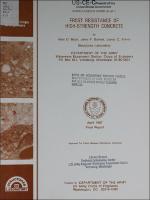Please use this identifier to cite or link to this item:
https://hdl.handle.net/11681/11068| Title: | Frost resistance of high-strength concrete |
| Authors: | Buck, Alan D. Burkes, J. P. Ahlvin, Joyce C. |
| Keywords: | Concrete Temperature effects Freezing Thawing Freeze-thaw cycle Frost resistance Frost resistant concrete |
| Publisher: | Structures Laboratory (U.S.) Engineer Research and Development Center (U.S.) |
| Series/Report no.: | Miscellaneous paper (U.S. Army Engineer Waterways Experiment Station) ; SL-87-1. |
| Description: | Miscellaneous Paper Abstract: High-strength concrete made with crushed granite as coarse aggregate but without air entrainment showed an average durability factor of 95 after 300 cycles of freezing and thawing in the laboratory. Determination of air content by American Society for Testing and Materials (ASTM) Designation: C 457 showed the unexpectedly good results were not the effect of protection afforded by air entrainment. Petrographic examination confirmed lack of damage on a microscopical scale. It was concluded that self desiccation and low permeability associated with an 0.24 water-cementitious solids ratio (W/S) prevented development of critical saturation so that the concrete behaved during testing as if it were not critically saturated and thus was not damaged by freezing. Similar concrete at the same W/S with crushed limestone as coarse aggregate showed a durability factor of 17. It is presumed that this is brought about by the lack of frost resistance of the limestone itself since in air-entrained concrete the specimens with granite coarse aggregate gave an average durability of 92, while those with limestone coarse aggregate gave an average durability of only 55. |
| Rights: | Approved for public release; distribution is unlimited. |
| URI: | http://hdl.handle.net/11681/11068 |
| Appears in Collections: | Miscellaneous Paper |
Files in This Item:
| File | Description | Size | Format | |
|---|---|---|---|---|
| MP-SL-87-1.pdf | 2.18 MB | Adobe PDF |  View/Open |